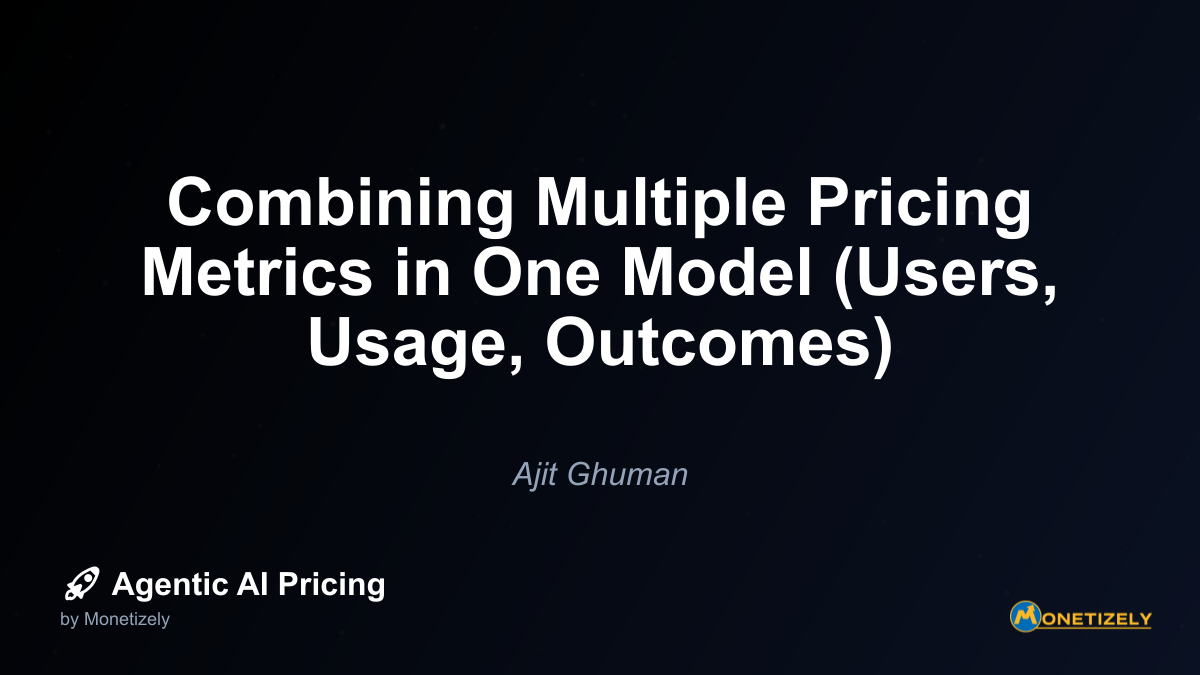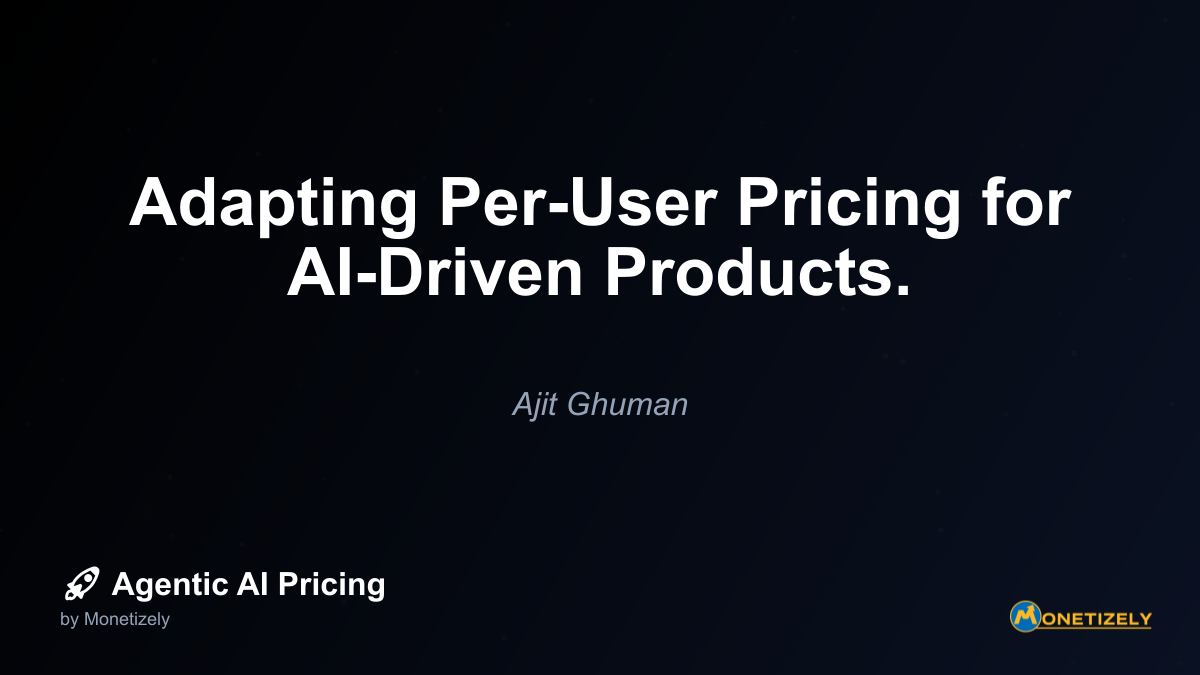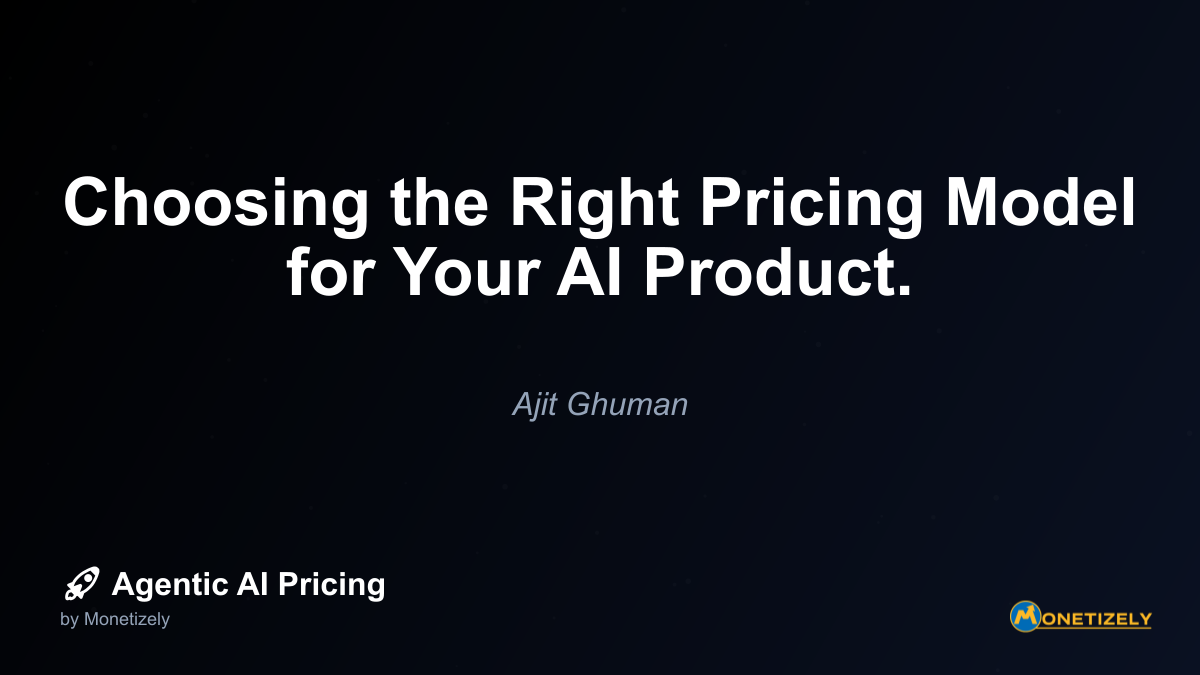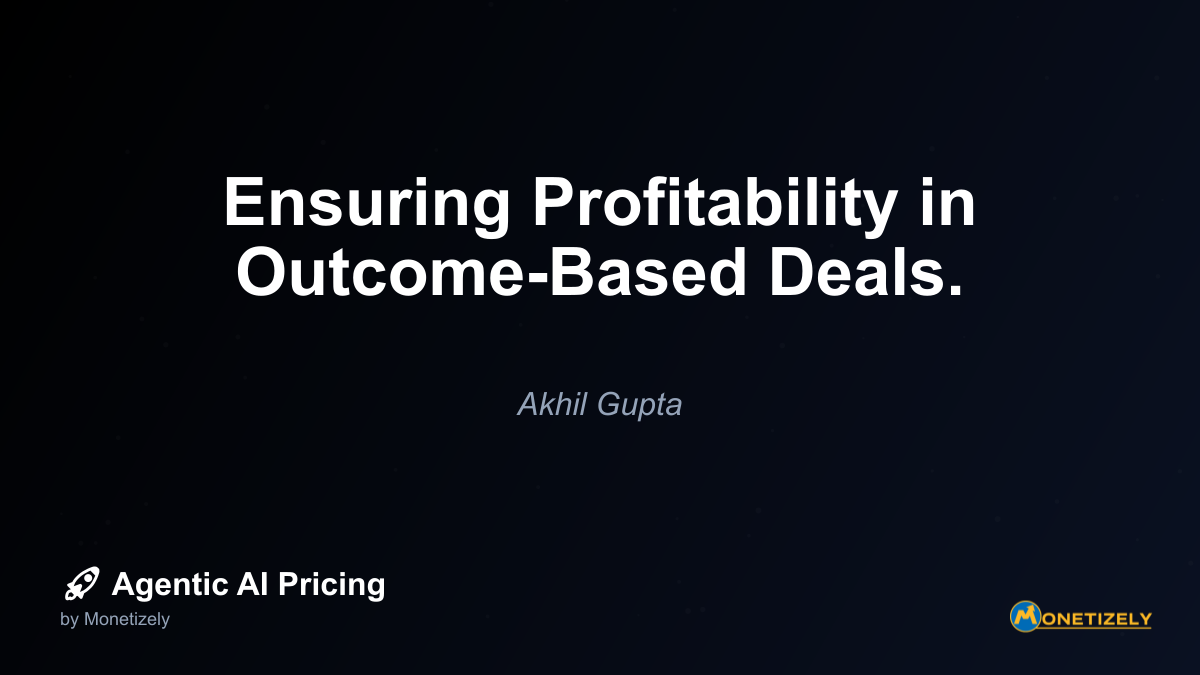· Ajit Ghuman · Agentic AI Pricing Strategies · 9 min read
Combining Multiple Pricing Metrics in One Model (Users, Usage, Outcomes)
AI and SaaS Pricing Masterclass
Learn the art of strategic pricing directly from industry experts. Our comprehensive course provides frameworks and methodologies for optimizing your pricing strategy in the evolving AI landscape. Earn a professional certification that can be imported directly to your LinkedIn profile.

Pricing models for AI products have evolved beyond simple subscription tiers or basic usage-based billing. Today’s most sophisticated AI platforms employ multi-metric approaches that balance platform access, user counts, actual usage, and value-based outcomes. While powerful, these complex models present unique design challenges to avoid customer confusion and maximize revenue potential.
The Evolution of AI Pricing Metrics
The journey of pricing models in software has followed a natural progression from simple to complex as technology capabilities and market understanding have matured. This evolution is particularly pronounced in the AI space.
Early software pricing typically relied on perpetual licensing models with maintenance fees. As SaaS emerged, subscription-based pricing became the norm, usually tied to user seats. However, AI products, especially agentic AI systems, often deliver value in ways that aren’t directly correlated with user count alone.
The AI pricing landscape has expanded to include:
- User-based metrics: Traditional per-seat or per-user pricing
- Usage-based metrics: Consumption measured in API calls, tokens, compute resources, etc.
- Outcome-based metrics: Value-driven pricing tied to specific business results
- Hybrid approaches: Combinations of the above
According to recent market analysis, over 65% of enterprise AI platforms now employ some form of multi-metric pricing model, reflecting the complexity of AI value delivery and the sophistication of buyers in this space.
Why Multi-Metric Pricing Makes Sense for Agentic AI
Agentic AI systems present unique pricing challenges. Unlike traditional software that provides a static set of features, agentic AI can:
- Perform diverse tasks across different domains
- Consume varying levels of computational resources
- Generate different types of business value
- Require different levels of human oversight
No single pricing metric can adequately capture this complexity. A strictly per-user model might undervalue heavy usage scenarios, while pure consumption-based pricing could create budget unpredictability for customers.
Consider an AI assistant platform that can generate content, analyze data, and automate workflows. Different organizations might derive value in completely different ways:
- Marketing teams value content generation capabilities
- Data science teams prioritize analytical functions
- Operations teams focus on workflow automation
A multi-metric approach allows AI providers to align pricing with this diverse value creation, capturing appropriate revenue across different use cases and customer segments.
Common Multi-Metric Combinations in AI Pricing
Several patterns have emerged as particularly effective in the agentic AI marketplace:
1. Base Platform Fee + Usage Components
This model starts with a foundational access fee that grants basic platform capabilities, then layers usage-based charges for specific activities or consumption.
Example: An AI research assistant might charge:
- $500/month platform fee (includes basic features and support)
- $0.05 per query
- $0.10 per document processed
This approach provides predictable base revenue while capturing additional value from high-volume users.
2. User Tiers + Outcome Fees
This combination ties pricing to both the scale of deployment (users) and the concrete business results generated.
Example: A sales enablement AI might price as:
- $100/user/month for core functionality
- 1% of incremental revenue generated through AI-identified opportunities
This aligns the vendor’s success with measurable customer outcomes while ensuring baseline revenue through the user component.
3. Tiered Access + Usage Allowances + Overages
This sophisticated model provides different service tiers with included usage amounts, then charges for consumption beyond those allowances.
Example: A customer service AI platform might offer:
- Basic tier: $1,000/month (includes 5 users, 1,000 customer interactions)
- Professional tier: $2,500/month (includes 15 users, 5,000 customer interactions)
- Enterprise tier: Custom pricing
- Overage fees: $50 per additional user, $0.10 per additional interaction
This approach allows customers to select their expected usage level while providing revenue upside for the vendor when usage exceeds predictions.
Designing Multi-Metric Models Without Confusing Customers
The primary challenge with multi-metric pricing is potential customer confusion. When pricing becomes too complex, it creates cognitive load that can impede purchasing decisions. Here are key strategies to implement complex models without overwhelming customers:
1. Establish a Clear Primary Metric
Even with multiple components, your pricing should have a dominant metric that customers readily understand. This serves as the anchor for their mental model of your pricing.
For example, Salesforce uses “per user per month” as its primary metric, even though its complete pricing model includes numerous other factors. This gives customers a clear starting point for understanding costs.
For agentic AI products, this primary metric might be:
- Number of AI agents deployed
- Core platform access fee
- Number of business processes automated
Secondary metrics should be positioned as modifiers or enhancements to this core pricing structure.
2. Use Packaging to Simplify Complexity
Rather than presenting every pricing variable independently, group related capabilities and their associated metrics into coherent packages.
Consider an AI document processing system with multiple potential metrics:
- Number of users
- Document volume
- Processing speed
- Accuracy requirements
- Integration complexity
Instead of pricing each dimension separately, you might create packages like:
- Essentials: Basic processing for small teams
- Business: Advanced processing with higher volume allowances
- Enterprise: Custom processing with SLAs and dedicated resources
Each package contains a specific combination of the underlying metrics, but customers see a simplified choice architecture.
3. Provide Clear Value Mapping
For each pricing component, explicitly connect it to the value it delivers. This helps customers understand why multiple metrics exist and how they relate to their specific use cases.
For example:
- Platform fee: Covers infrastructure, security, and basic capabilities
- Per-user fee: Reflects the value of individual productivity enhancements
- Outcome fee: Aligns with measurable business impact
This value mapping should be prominent in marketing materials, pricing pages, and sales conversations.
4. Offer Predictable Billing Options
Usage-based components introduce billing variability that can make customers uncomfortable. Address this by providing options for predictability:
- Usage caps that prevent unexpected charges
- Prepaid usage credits at discounted rates
- The ability to convert variable components to fixed fees based on historical usage
For instance, an AI coding assistant might offer customers the choice between strictly usage-based pricing or a higher fixed monthly fee with unlimited usage within reasonable bounds.
5. Use Interactive Tools for Transparency
Pricing calculators and simulators allow customers to model different usage scenarios and understand how multi-metric pricing will affect their specific situation.
These tools should:
- Allow input of expected usage across all relevant dimensions
- Show how costs scale with different usage patterns
- Compare different packaging options
- Provide recommendations based on usage profiles
By making the pricing model interactive, you transform complexity from a barrier into an engagement opportunity.
Case Study: Multi-Metric Success in Agentic AI
Let’s examine a hypothetical but realistic example of successful multi-metric pricing for an agentic AI platform called “TaskForge AI.”
TaskForge AI provides autonomous agents that can perform various business tasks across departments. Their initial pricing model was a simple per-agent fee of $1,000/month, but this created several problems:
- Small companies found the entry price too high
- Large enterprises with simple use cases felt overcharged
- Companies creating significant business value felt the pricing was disconnected from outcomes
After careful analysis, TaskForge implemented a multi-metric model:
Base Platform Fee:
- Starter: $500/month (includes 1 agent)
- Business: $2,000/month (includes 5 agents)
- Enterprise: $10,000/month (includes 30 agents)
Per-Agent Fee:
- $200/month for each additional agent
Task Execution Fee:
- $0.10 per standard task
- $0.50 per complex task
Value Share Component:
- Optional: 0.5% of documented cost savings for workflow automation use cases
This multi-metric approach delivered several benefits:
- Lower entry price point increased adoption among small businesses
- Usage-based component ensured heavy users paid proportionally
- Value share option aligned pricing with outcomes for cost-saving applications
- Overall revenue increased by 45% within six months
To prevent customer confusion, TaskForge implemented:
- A simple pricing calculator on their website
- Clear documentation explaining each pricing component
- Standardized ROI measurement methodology
- Quarterly usage reviews with recommendations
The result was a pricing model that more accurately reflected value delivery across diverse customer segments while remaining comprehensible to buyers.
Implementation Roadmap for Multi-Metric Pricing
Transitioning to a multi-metric pricing model requires careful planning and execution. Here’s a phased approach:
Phase 1: Research and Analysis (1-2 months)
- Analyze current customer usage patterns across potential metrics
- Identify value drivers for different customer segments
- Benchmark against competitive pricing models
- Model revenue impact of different multi-metric structures
Phase 2: Model Design (1 month)
- Define primary and secondary metrics
- Create packaging structure
- Set specific price points
- Develop internal pricing tools
Phase 3: Pilot Testing (2-3 months)
- Select representative customer cohort
- Implement new model with pilot group
- Gather feedback on comprehension and acceptance
- Refine model based on real-world usage
Phase 4: Go-to-Market Preparation (1 month)
- Develop customer-facing pricing materials
- Build pricing calculators and simulators
- Train sales team on new model
- Prepare migration plan for existing customers
Phase 5: Rollout (3-6 months)
- Launch for new customers
- Gradually migrate existing customers
- Monitor key metrics (conversion rates, ARPU, churn)
- Iterate based on market feedback
Throughout this process, maintain clear communication with customers about the rationale behind the pricing changes and how they align with value delivery.
Common Pitfalls to Avoid
When implementing multi-metric pricing for agentic AI, watch out for these frequent mistakes:
1. Metric Overload
Problem: Including too many pricing dimensions creates cognitive overload.
Solution: Limit your model to 2-3 primary metrics that customers can easily understand and track. Additional factors should be incorporated into packaging rather than presented as separate variables.
2. Misaligned Metrics
Problem: Choosing metrics that don’t correspond to how customers perceive value.
Solution: Validate metric selection through customer interviews and usage analysis. Ensure each component clearly connects to a specific value dimension.
3. Unpredictable Billing
Problem: Usage-based components leading to bill shock and budget concerns.
Solution: Implement usage notifications, caps, and visualization tools. Consider offering “committed use” discounts for predictable billing.
4. Sales Team Resistance
Problem: Complex models creating challenges for sales execution.
Solution: Develop robust sales enablement tools, training programs, and simplified frameworks for common customer scenarios.
5. Operational Complexity
Problem: Difficulty in implementing and maintaining complex pricing in billing systems.
Solution: Ensure your technical infrastructure can support multi-metric models before launch. Consider phased implementation if necessary.
Future Trends in Multi-Metric AI Pricing
As the agentic AI market continues to evolve, several trends are emerging in multi-metric pricing:
1. Dynamic Metric Weighting
Advanced AI pricing models are beginning to dynamically adjust the importance of different metrics based on usage patterns and value creation. This allows the pricing model to adapt to how customers actually use the product rather than imposing a static structure.
2. Outcome Guarantees
Building on outcome-based components, some AI vendors are offering guaranteed results with refund mechanisms if certain thresholds aren’t met. This shifts some risk from customer to vendor while potentially increasing willingness to pay.
3. Ecosystem Pricing
As AI platforms expand into ecosystems with multiple capabilities, pricing is evolving to cover not just core functionality but also marketplace additions, integrations, and partner components.
4. Sustainability Metrics
Environmental impact of AI computation is becoming a consideration in pricing models, with incentives for efficient resource usage and penalties for excessive consumption.
Conclusion
Multi-metric pricing models represent the frontier of monetization strategy for agentic AI platforms. When thoughtfully designed, these approaches can align pricing with diverse value creation mechanisms, maximize revenue potential, and create sustainable customer relationships.
The key to success lies in balancing sophistication with comprehensibility – creating models that accurately reflect complex value delivery without overwhelming customers with complexity.
For AI platform providers, the journey toward optimal pricing is continuous. As technology capabilities evolve and market understanding deepens, pricing models should adapt accordingly. The most successful vendors will view pricing not as a static decision but as a dynamic element of their product strategy, continuously refined based on customer feedback and market response.
By combining user-based, usage-based, and outcome-based metrics in thoughtful ways, AI platforms can create pricing models that scale appropriately with value creation while remaining transparent and predictable for customers.
Co-Founder & CEO
Ajit is the author of Price To Scale, a top book on SaaS Pricing and is the Founder of Monetizely. Ajit has led and worked in pricing and product marketing at firms like Twilio, Narvar and Medallia. His work has been featured in Forbes and VentureBeat. Ajit regularly consults with software companies from Seed stage to post-IPO on pricing strategy. Ajit is also a highly-rated co-instructor for 'The Art of SaaS Pricing and Monetization' on Maven.
Pricing Strategy Audit
Let our experts analyze your current pricing strategy and identify opportunities for improvement. Our data-driven assessment will help you unlock untapped revenue potential and optimize your AI pricing approach.




